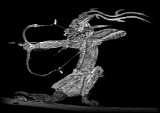
Asian Traditional Archery Research Network (ATARN)
Text and
photographs © Stephen Selby, 2000 - 2002.
A1, Cloudridge,
30, Plunkett’s Road,
The Peak, Hong Kong.
Fax: (852) 2808-2887
email: srselby@atarn.org
January/February 2002
Dear All,
It's rare for me to get side-tracked from ATARN by my real work (the stuff people pay me for); but in January I have been, so I owe you an apology (a) for failing to wish you a very happy new year, and (b) for failing to provide a newsletter.
ATARNet
Due to my misunderstanding of the instruction manual for
ATARNet's message board software, I deleted the old messages on
ATARNet and placed them in an archive. (I had thought I was backing them up!)
That is a nuisance, but not a disaster. The previous messages are preserved in
the Archive. If you
want to reply to an archived message, you'll have to make a new post on ATARNet
and make a link to the archived message. Sorry! Won't happen again.
Museum
The opening of Hong Kong's archery museum at the Museum of Coastal Defence will have to be put back to June (I mentioned May in the last letter.) We are planning a mini-symposium on Asian archery and bow-making at that time, and I hope to let you have the details before long. There will also be a television programme on Asian archery produced by Radio Television Hong Kong which should be ready for airing in July. To help with the museum project and the television programme, please would you lend me your video footage of Asian archery technique from any Asian cultures?
The 12th Asian Archery Championships were held in Hong Kong from December 10 - 15, 2001. At the kind invitation of Joe Lam I went to 'cover' the event for ATARN.
Needless to say, this was an competition with counter-weights, clickers, sights and shock-dampers. What was there for Asian traditional archers? My idea was to use this opportunity, when Hong Kong was being honoured with visits from the top FITA archers from Asia, to sound out their awareness and feeling for traditional archery in their own countries. The results were interesting, in some cases exciting and in others disappointing.
Myanmar (Dr. Khin Shwe, President of the Myanmar Archery Federation): "Certainly we have traditional archery. We have the Naga, Shan and Karen peoples hunting with bows and crossbows in the forest, using poison arrows."
Sri Lanka. (H. R. Wickramasinghe, Team Member): "The Weddas still live in parts of Sri Lanka, although much assimilated. Some time ago, when we were building up archery in Sri Lanka, we went to seek out Weddas who could be trained to shoot in the Western fashion."
Philippines. (Ramon Lim, President of the National Archery Assoc. of the Philippines): "The Aita tribespeople of Mindoro shoot with bamboo bows and arrows for hunting."
Korea. (Prof. Sung-Ho Um Ph D. Director, Korean Archery Association): "As you know, traditional archery is very strong in Korea. But perhaps you didn't know that traditional archery and modern archery in Korea only split in 1983. Before that, they were a single discipline. The Korean traditional bow has to hit a target at over 140 metres, so the bows have to be very heavy (around 40-50lbs). For this reason in Korea, children starting archery at about ten years old have to begin with western archery, and they don't get introduced to traditional archery until later when they are strong enough."
Kasakhstan. (Irina Korotraya, Team member): "Nyet. Nyichyevo."
Islamic Republic of Iran. (Abdol Vaheed Fadee Ebrahami, Team member): "There's no more traditional archery in Iran; but that is not to say we are not interested. Actually, our coach, Mr. Khosroo Shahbandi, is very interested in traditional archery and he has an old Persian bow in his home. "
There were other teams; but I didn't get a chance to interview them. I came away with a strong feeling that ATARN could do some outreach to Modern archers in Asia, encouraging countries who no longer have a strong archery tradition to research and try to revive some traditional shooting. I can see particular potential in the warm responses I got from Iran and Sri Lanka.
Ah! Them thingies!
My interest in 'Thingies' continues unabated. You will recall my article from 2000, Thingies Up-close and Personal and the Follow-Up Discussion that ensued on the Discussion Forum. Since that time, ATARN readers have emailed me with their ideas.
In the meantime, I have been scrutinizing archaeological reports of new excavations of thingies. Several have appeared in the past two years. I have also purchased a further pair of thingies which are in their original, excavated condition and provide some interesting clues.
Archaeological reports have offered no new
evidence of thingies in the context of bows and arrows. However, a good report
was published in 'Archaeology' ('Kaogu') 2000.7 p. 13 of an excavation of a Shang/Zhou
grave at Tengzhou in
Shandong. Grave #4 contained a well-preserved two-horse chariot burial with a
single human skeleton in the usual position under the rear of the chariot. The thingie
in this burial was at the forward edge of the platform of the chariot, and not associated
with the corpse or any archery items. It was, however, associated with a dagger
axe and a number of belt-related items.
This consistent relationship between thingies and belt items suggests that Adam Karpowicz's view in his contribution in February 2000 were correct -
"... ...Based on the above, I believe the
thingies were tied to the soldier's belt at his waist. The reins would be hooked
over the projections, easily accessible in case the horses needed to turn, stop
etc. The base of the thingie is curved to
follow a contour of the soldiers belly and wide enough not to drop down when
tied. Traces of lashing were found at the junction of the base and the
projections."
His comment reminded me at that time of some very large thingies I have seen, which could hardly have been associated with a bow, but would have nicely fitted a large charioteer's belly.
Last year, I purchased two more thingies. Here are photographs of them.
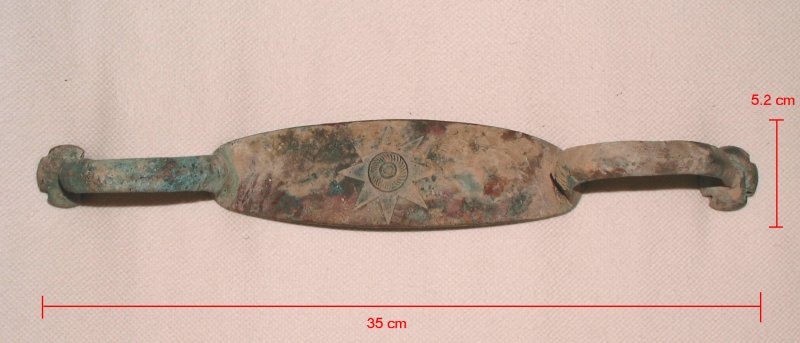
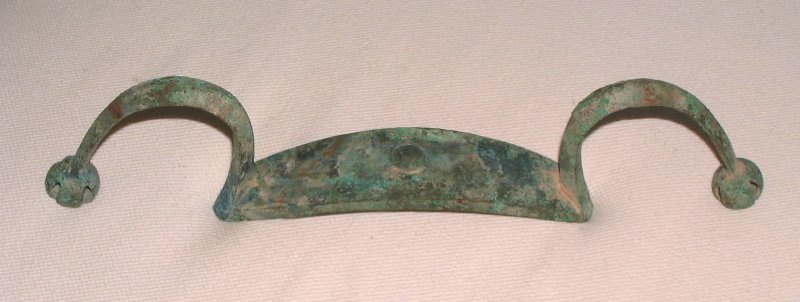
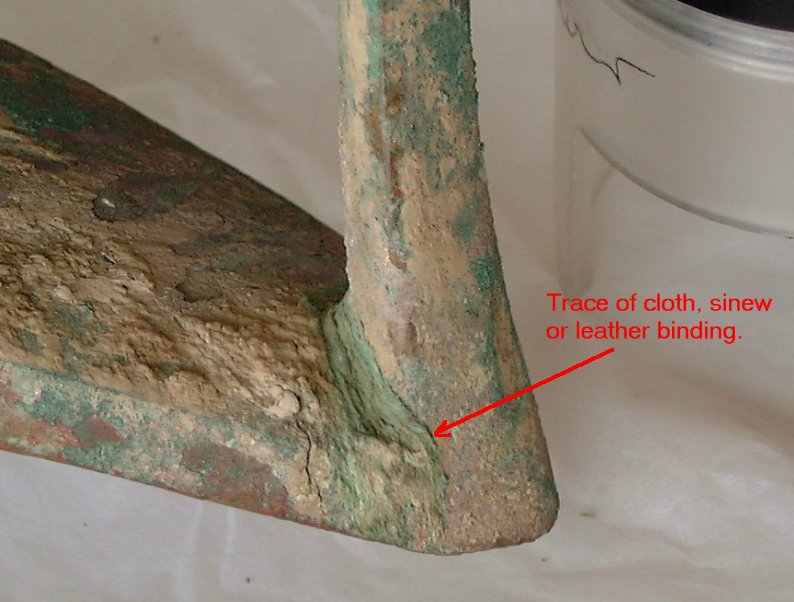
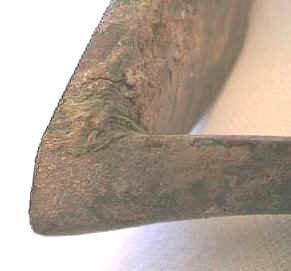 These
traces of bindings suggest a rather flimsy attachment to whatever was underneath.
Why would that be? The answer must be that a driver wanting to hang the reins of
two galloping horses would be keen to ensure that in case of an accident, he was
not firmly attached to the reins. A leather thong at the position indicated in
the photograph above would be sufficient to keep the thingy firmly on the belt,
but break off if the driver started to be dragged. It is similar to the idea
that if you tie a horse by a lead-rein in a stable, you tie the lead rein to a
string, and not directly to a bar, in case the horse bucks in a panic and breaks
its jaw.
These
traces of bindings suggest a rather flimsy attachment to whatever was underneath.
Why would that be? The answer must be that a driver wanting to hang the reins of
two galloping horses would be keen to ensure that in case of an accident, he was
not firmly attached to the reins. A leather thong at the position indicated in
the photograph above would be sufficient to keep the thingy firmly on the belt,
but break off if the driver started to be dragged. It is similar to the idea
that if you tie a horse by a lead-rein in a stable, you tie the lead rein to a
string, and not directly to a bar, in case the horse bucks in a panic and breaks
its jaw.
An ATARN reader recently drew my attention to a British Museum web page (http://www.ancientegypt.co.uk/pharaoh/story/main.html) with an illustration of an ancient Egyptian charioteer, Pharaoh Ramesses II, whose chariot reins were attached to his belt (although no thingies are in evidence.)
Unnecessary when riding a horse because other aids are available, thingies would be indispensable if you were a charioteer on a chariot drawn by two horses with simple reins. You would be able to wrap the left rein pair on the left hand horn of the thingy and the right pair on the right. You could keep mouth contact while your hands were engaged elsewhere, steer to left or right by rotating your hips and regain the reins quickly.
Someone needs to try this out. Not me, thanks. And at your own risk.
Dave and Meg Beshey have emailed to advise that the 2002 International Horse Archery Festival will be held at Fort Dodge, Iowa, USA from 5 - 9 September 2002. They will soon be publishing details there and I will mirror them on ATARN.
|
|
(Signed) (Stephen Selby) |